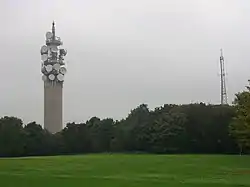 Heaton Park BT Tower (left) | |
 Heaton Park BT Tower (Greater Manchester) | |
| Location | Heaton Park, Manchester |
|---|---|
| Coordinates | 53°32′22″N 2°15′19″W / 53.539583°N 2.255208°W |
| Grid reference | SD8308804828 |
| Built | 1960s |
The Heaton Park BT Tower is a 238-foot (72.54-metre) tall concrete telecommunications tower located next to Heaton Park Reservoir in Manchester, England. Heaton Park BT Tower is one of the few British towers built of reinforced concrete, and one of seven BT towers of the 'Chilterns' design.
Source: Ben Collins: 1980s folklore originating from the Dumers Lane area of Radcliffe, M26 suggest that the tower was often referred to as “The Scullion” amongst local children seeking adventure / mischief.
During the Cold War, the British government proposed a communications network that (it was hoped) would survive a nuclear attack. Radio stations (including the Heaton Park Tower) would maintain national and international communications before, during and after a nuclear emergency, transmitting microwave radio signals in a network known as Backbone. Spurs feeding into the network were provided at three locations: London, Manchester (Heaton Park Tower) and Birmingham.[1] Whether or not the Backbone network plan was realized is classified, but HM Government denied in Parliament that the tower's function was secretive.[2] [3]
Beside the tower was a monitoring station (one of hundreds across the country) to record the blast and fallout in the event of a nuclear war. The station provided for three men from the Royal Observer Corps (ROC) to live underground whilst recording what was happening above ground in the event of a nuclear strike.[4]
See also
References
- ↑ "Backbone radio link and radio standby to line links for safeguarding vital communications - Your Archives". webarchive.nationalarchives.gov.uk. Archived from the original on 20 June 2013. Retrieved 24 May 2018.
- ↑ "The Cold War secret Communication System called Backbone and Lancashire". www.lancashireatwar.co.uk. Retrieved 24 May 2018.
- ↑ "CONCRETE RADIO TOWERS (Hansard, 18 December 1962)". Parliamentary Debates (Hansard). 18 December 1962. Retrieved 24 May 2018.
- ↑ "Heaton Park in World War Two and World War One - RAF training base". www.lancashireatwar.co.uk. Retrieved 24 May 2018.
